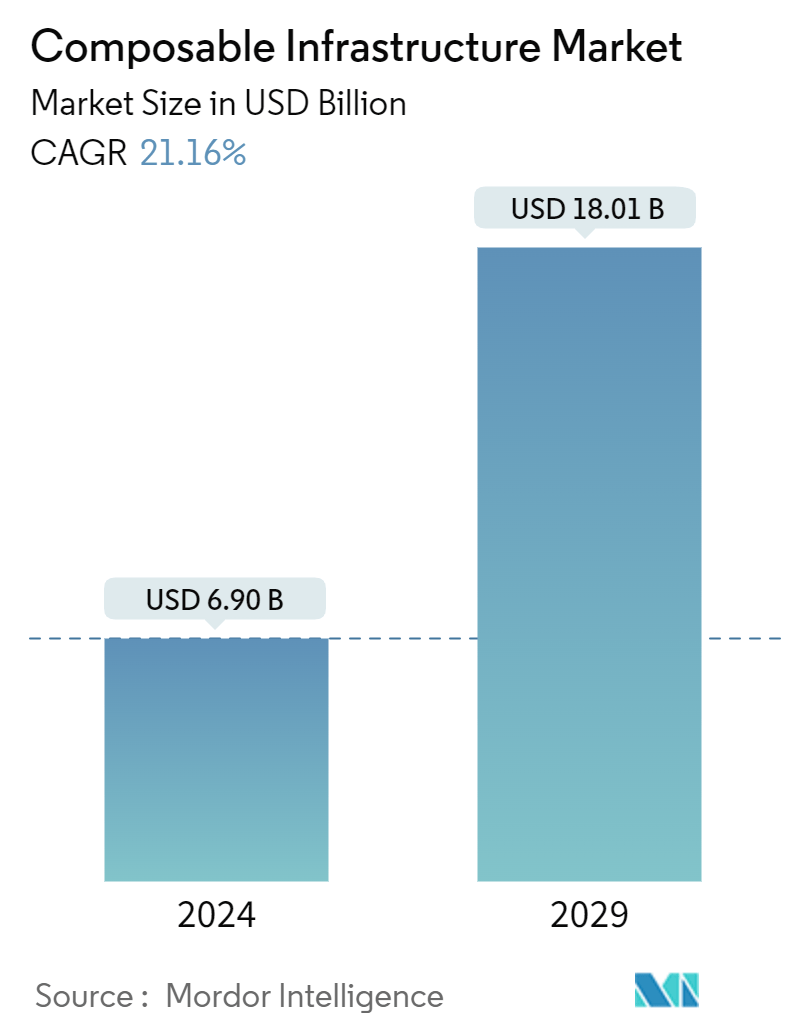Market Size of Composable Infrastructure Industry

| Study Period | 2019 - 2029 |
| Market Size (2024) | USD 6.90 Billion |
| Market Size (2029) | USD 18.01 Billion |
| CAGR (2024 - 2029) | 21.16 % |
| Fastest Growing Market | Asia Pacific |
| Largest Market | North America |
| Market Concentration | High |
Major Players
*Disclaimer: Major Players sorted in no particular order |
Composable Infrastructure Market Analysis
The Composable Infrastructure Market size is estimated at USD 6.90 billion in 2024, and is expected to reach USD 18.01 billion by 2029, growing at a CAGR of 21.16% during the forecast period (2024-2029).
- Composable infrastructure is the IT infrastructure created by separating distinct components of the data center architecture, such as computation, networking, and storage, and combining them in numerous ways to meet the needs of specific workloads. Increased customer expectations, expanding business analytics workload, deployment of DevOps approaches, the development of automation and standardization technologies, and the increasing acceptance of hybrid cloud are all expected to boost the growth of the composable infrastructure market.
- Businesses increasingly adopt composable infrastructure solutions to reduce capital expenditures and enhance infrastructure utilization. Composable infrastructure enables the dynamic assembly and disassembly of resources based on application demands. This allows for the optimized allocation of pooled resources, improving overall infrastructure efficiency.
- Additionally, composable infrastructure supports flexibility and agility by facilitating rapid provisioning, re-provisioning, and upgrading infrastructure. The ability to integrate existing hardware with software-defined infrastructure is also driving adoption. The rapid growth in data volumes and infrastructure virtualization across industries is expected to impact the market positively.
- The shortage of skilled workers prevents the start of some composable infrastructure projects. However, even if they are tackled, the need for experienced professionals often extends the project duration. Since the European labor market does not produce appropriately qualified workers, innovations are expected to fail even if the company has sufficient financial resources.
- In the current scenario, the macroeconomic situation remains volatile, and players continue to see macro trends such as high interest rates, inflation, fear of recession, and geopolitical tensions increasing in some parts of the world, which can impact the industrial activities in the future, and can impact the demand for the market. In April 2024, UN Trade and Development (UNCTAD) forecasted global economic growth to slow at 2.6%, marginally above the 2.5% threshold commonly associated with a recession, which would lower the market growth.
Composable Infrastructure Industry Segmentation
Composable infrastructure offers value to continue business operations and development by providing increased efficiencies in the system infrastructure operations. The analysis is based on the market insights captured through secondary research and the primaries. The market also covers the major factors impacting the growth of the market in terms of drivers and restraints. The study’s scope tracks the adoption of composable infrastructure solutions used by various end-user verticals in multiple geographies, including their shares, based on inputs received from the industry stakeholders covering both software and hardware.
The composable infrastructure market is segmented by type (software, hardware), by end-user verticals (IT and telecom, BFSI, healthcare, industrial manufacturing, and other end-user verticals), and by geography (North America, Europe, Asia Pacific, Rest of the World). The report offers market forecasts and size in value (USD) for all the above segments.
| By Type | |
| Software | |
| Hardware |
| By End User Verticals | |
| IT and Telecom | |
| BFSI | |
| Healthcare | |
| Industrial Manufacturing | |
| Other End-user Verticals |
| By Geography*** | |
| North America | |
| Europe | |
| Asia | |
| Australia and New Zealand | |
| Latin America | |
| Middle East and Africa |
Composable Infrastructure Market Size Summary
The composable infrastructure market is poised for significant growth, driven by the increasing need for flexible and efficient IT solutions. This market is characterized by the ability to dynamically assemble and disassemble data center resources, such as computation, networking, and storage, to meet specific workload demands. The adoption of composable infrastructure is being fueled by factors such as the rising expectations of customers, the expansion of business analytics workloads, and the deployment of DevOps approaches. Additionally, the development of automation and standardization technologies, along with the growing acceptance of hybrid cloud solutions, is expected to further propel market growth. Despite challenges like a shortage of skilled professionals and macroeconomic uncertainties, the market is witnessing a surge in demand, particularly in sectors like telecommunications, where composable infrastructure is seen as a critical component in the deployment of fifth-generation (5G) networks.
North America leads the composable infrastructure market, with the United States playing a pivotal role due to the presence of major solution providers like Cisco, Juniper Networks, and Hewlett Packard Enterprise. These companies are actively engaging in partnerships, mergers, and acquisitions to enhance their offerings and maintain a competitive edge. The region's dominance is also supported by advancements in network automation and the increasing adoption of cloud-based services. The market is highly fragmented, with both global players and SMEs contributing to its growth. Strategic collaborations, such as those between Wipro and Nutanix, and Lenovo and Cisco, are aimed at accelerating digital transformations and expanding market reach. These partnerships, along with ongoing product innovations and capital investments, underscore the growing acceptance and demand for composable infrastructure solutions across various industries.
Composable Infrastructure Market Size - Table of Contents
-
1. MARKET INSIGHTS
-
1.1 Market Overview
-
1.2 Industry Attractiveness - Porter's Five Forces Analysis
-
1.2.1 Bargaining Power of Suppliers
-
1.2.2 Bargaining Power of Consumers
-
1.2.3 Threat of New Entrants
-
1.2.4 Threat of Substitutes
-
1.2.5 Competitive Rivalry Within the Industry
-
-
1.3 Industry Value Chain Analysis
-
1.4 Assessment of the Impact of Macro Economic Factors on the Market
-
-
2. MARKET SEGMENTATION
-
2.1 By Type
-
2.1.1 Software
-
2.1.2 Hardware
-
-
2.2 By End User Verticals
-
2.2.1 IT and Telecom
-
2.2.2 BFSI
-
2.2.3 Healthcare
-
2.2.4 Industrial Manufacturing
-
2.2.5 Other End-user Verticals
-
-
2.3 By Geography***
-
2.3.1 North America
-
2.3.2 Europe
-
2.3.3 Asia
-
2.3.4 Australia and New Zealand
-
2.3.5 Latin America
-
2.3.6 Middle East and Africa
-
-
Composable Infrastructure Market Size FAQs
How big is the Composable Infrastructure Market?
The Composable Infrastructure Market size is expected to reach USD 6.90 billion in 2024 and grow at a CAGR of 21.16% to reach USD 18.01 billion by 2029.
What is the current Composable Infrastructure Market size?
In 2024, the Composable Infrastructure Market size is expected to reach USD 6.90 billion.

